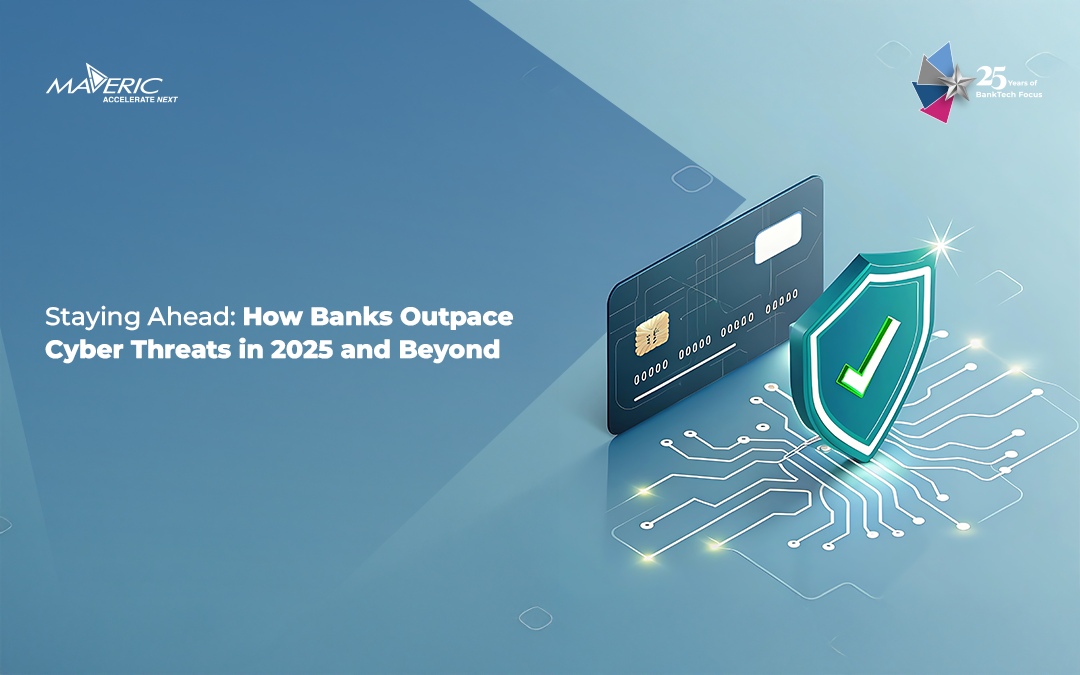Staying Ahead: How Banks Outpace Cyber Threats in 2025 and Beyond

An Evolving Threat Scape
Cyber threats targeting BFSI organizations are escalating in both frequency and sophistication. A recent Accenture study shows that 45% of cyberattacks worldwide target the financial services sector, making it the most attacked industry. From ransomware to supply chain compromises, banks grapple with an onslaught of attack vectors that can cripple operations and undermine customer trust.
“Banks must treat cybersecurity like oxygen—ever-present, essential, and non-negotiable.”
Kishan Sundar, Senior vice president and CTO at Maveric Systems, underscores the urgency for BFSI leaders to move beyond reactive measures. Preparing for 2025 and beyond demands a proactive, multi-layered security posture.
Mapping the Modern Threat Landscape
1. Ransomware as a Service (RaaS): Cybercrime has evolved into a gig economy. RaaS kits are sold or rented on the dark web, enabling even low-skilled attackers to execute sophisticated campaigns.
2. API Vulnerabilities: While fostering innovation, open banking also expands the attack surface. If not secured, APIs can be a gateway for malicious actors to siphon data or inject harmful payloads.
3. AI-Driven Attacks: Cybercriminals increasingly employ AI for automated scans, intelligent phishing, and advanced evasion techniques. Financial institutions must respond with equally advanced defenses.
The Multi-Layered Defense Strategy
1. Continuous Threat Monitoring: Deploying AI-driven Security Information and Event Management (SIEM) systems offers real-time insights into unusual network or user behavior. By integrating global threat intelligence feeds, banks can gain foresight into emerging attacker tactics.
2. Encryption and Tokenization: Encryption remains a baseline security measure, but many BFSI players are also implementing tokenization—replacing sensitive data with tokens—thereby reducing the risk of data exposure. This approach has gained traction, especially with rising contactless and mobile payment systems.
Zero Trust Architecture
In a zero-trust model, no user or device is implicitly trusted. Adopting micro-segmentation, multi-factor authentication, and context-aware access ensures that even if attackers breach one segment, they can’t quickly pivot to critical systems.
The Human Factor
Employee accidents and oversights often serve as a gateway for attackers. Regular cybersecurity training and phishing simulations can dramatically reduce human error incidents. Many leading banks now host monthly “cyber drills” to keep staff vigilant about social engineering threats.
Resilience and Incident Response
While prevention is key, being prepared to respond to inevitable incidents remains critical. A robust incident response plan outlines responsibilities, timelines, and communication strategies for various breach scenarios. Conducting tabletop exercises helps refine these plans under realistic conditions.
Case Insight: Predictive Analytics at Work
A European bank integrated a predictive analytics engine into its fraud detection framework. Using AI models trained on millions of transactions, the system identifies anomalies in real-time, flagging suspicious patterns often missed by traditional rule-based systems. Within nine months, the bank reported an 80% drop in undetected fraudulent transactions and a 25% reduction in false positives, enhancing security and customer experience.
Regulatory Overlap
Financial institutions operate within a complex regulatory matrix—GDPR in the EU, PCI-DSS for payment data, RBI mandates in India, etc. While compliance can feel burdensome, forward-looking BFSI leaders leverage these frameworks to elevate security standards. Annual audits, third-party assessments, and cross-functional compliance squads ensure that security protocols align with ever-evolving rules.
The Role of Collaboration
Collaboration extends beyond internal teams. Banks benefit from industry alliances such as the Financial Services Information Sharing and Analysis Center (FS-ISAC), which disseminate threat intelligence across institutions. By sharing information about emerging threats and vulnerabilities, BFSI players can collaboratively fortify their defenses, making it more difficult for attackers to succeed across the sector.
Future-Proofing Cybersecurity
1. AI Augmentation: Machine learning models that self-tune based on new data can adapt to advanced threats.
2. Quantum-Safe Cryptography: Early exploration of quantum-resistant algorithms ensures that banks aren’t caught off-guard by future computing breakthroughs.
3. Sustainable Workforce: The cybersecurity skills gap persists. Continuous training, certification programs, and robust career pathways can help banks retain skilled professionals.
Conclusion: Vigilance as a Strategic Asset
For BFSI leaders, cybersecurity transcends IT oversight; it’s a board-level priority. Attackers are relentless, but so must the defenders. By prioritizing multi-layered defenses, continuous monitoring, and a culture of awareness, banks can stay ahead of evolving threats and secure their assets and reputations.
“In an era of digital everything, a complacent approach to security is unacceptable. Staying ahead requires continuous evolution—of strategies, technologies, and mindsets.”
Kishan Sundar emphasizes that cybersecurity isn’t a one-and-done exercise. It’s a dynamic, evolving endeavor. Banks that adopt this mindset will not only thwart today’s attackers but also be well-positioned to combat tomorrow’s threats.
List of Further Reading & Citations
- How Banks Stay Ahead of Cyber Threats
- Accenture (2023). Cost of Cybercrime Study.
- RBI (2022). Guidelines for Payment Security.
- Gartner (2023). Zero Trust in Financial Institutions.
View
















